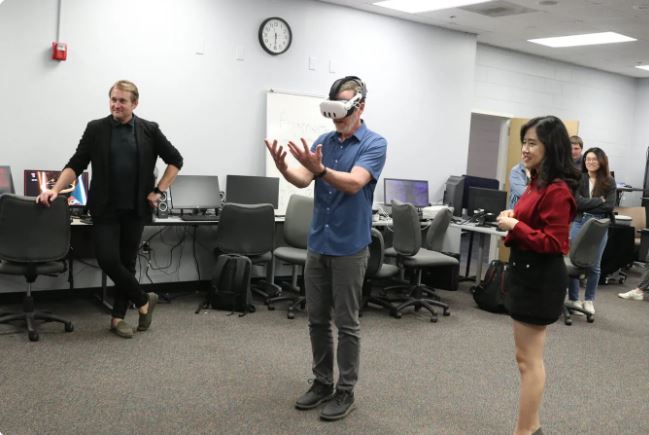When Teen Stress Impacts Parents’ Hearts: UGA Research Explores Surprising “Crossover Effects”

How does a teenager’s stress ripple through the family—beyond the emotional tension—to affect their parents’ physical health?
That’s the central question driving a newly funded research project led by University of North Carolina–Chapel Hill’s Dr. Melissa Lippold, in collaboration with Dr. Katherine Ehrlich, University of Georgia Professor of Psychology and a Distinguished Scholar at the Owens Institute for Behavioral Research, whose Health and Development Laboratory will spearhead the UGA portion of the work.
The five-year, $3.3 million study, titled “Examining the Crossover Effects of Adolescent Stress on Parent Cardiovascular Health,” is supported by the National Heart, Lung, and Blood Institute (NHLBI), with $2.4 million awarded to UGA. The project launched in September 2025 and will follow 400 parent–child pairs across Athens and surrounding areas starting this spring.
A Friendship Turned Research Partnership
Ehrlich and Lippold’s collaboration began as many great scientific partnerships do—with a shared interest and a wonderful idea.
“I had been working on a proposal about how adolescents’ stress during the transition to middle and high school might be linked to their own cardiometabolic health,” Ehrlich said. “But we kept missing the payline—sometimes by just a couple of points.”
Lippold suggested expanding the idea to include “crossover effects”—how stress in adolescents might transfer to affect parents’ health. “We quickly realized we could examine both sets of questions within the same framework,” Ehrlich recalled. “That insight turned out to be the key.”
The two researchers first met in 2005 during graduate school interviews and have been sharing ideas ever since. “We’ve been informally bouncing ideas off each other for nearly two decades,” Ehrlich said. “It’s been amazing to see how that long-term friendship evolved into a project of this scale.”
Inside the Study: Tracking Stress and Health in Real Time
Cardiovascular disease (CVD) remains one of the leading causes of death in the U.S., disproportionately affecting minority and low-income populations. Decades of evidence show that daily stressors and strong emotional reactivity to those stressors elevate risks for cardiometabolic disease and inflammation—two major predictors of CVD.
What’s new is the project’s focus on how adolescent stress might “crossover” to influence parent health. Early pilot data from Lippold’s lab revealed that, on days when adolescents experienced stressors, their parents were more likely to report negative mood, physical symptoms such as headaches or fatigue, and elevated cortisol—a stress hormone linked to heart disease.
The new study will dig deeper into those patterns. Over the next five years, the team will:
- Recruit 400 families with children entering 6th or 9th grade.
- Conduct in-lab assessments of stress, social relationships, and baseline health.
- Have parents and adolescents complete two weeks of nightly surveys to capture daily stressors and emotional responses.
- Follow each family for 18 months to see how adolescent stress predicts changes in parent cardiovascular health and inflammatory markers.
By combining new primary data with analyses of an existing parent-child dataset, the research will test whether findings hold across different racial, ethnic, and socioeconomic groups—providing a rare opportunity to examine health disparities in stress transmission.
Why It Matters
Parenting adolescents can be both rewarding and stressful. This project aims to uncover how those daily stressors matter for parents’ physical health and identify modifiable pathways—such as poor sleep, worry, or strained family communication—that might amplify or buffer those effects.
Ultimately, the findings will guide the design of future interventions to help parents respond to teen stress in ways that protect their own cardiovascular health. “If we can pinpoint the mechanisms linking adolescent stress to parent health, we can design strategies that promote resilience in both generations,” Ehrlich explained.
The Human Side of Science
For Ehrlich, the project reflects the unpredictable but rewarding path of research. “Research trajectories often look linear in hindsight,” she said, “but in reality, they’re shaped by timing, collaboration, and a fair amount of luck. This grant is a perfect example—it started as a companion idea and became the centerpiece of our next five years.”
She also praised the Owens Institute for Behavioral Research and UGA’s Center for Family Research for their support. “The OIBR team was incredible, especially during those chaotic submission cycles when I had two or three proposals going at once,” she said.
And while the work is challenging—tracking participants over years, managing complex data systems—Ehrlich finds joy in the teamwork behind it all. “When everything is running smoothly—data coming in, students learning, analyses progressing—it feels like we’re all part of something bigger. That’s what I love most about this work.”
Learn More
Families interested in participating or following the project’s progress can visit the Health and Development Laboratory website: https://www.healthanddevelopmentlaboratory.com
Written by: Andrea Horsman
November 13, 2026




 Owens Institute for Behavioral Research Announces 2025 Distinguished Scholars
Owens Institute for Behavioral Research Announces 2025 Distinguished Scholars




